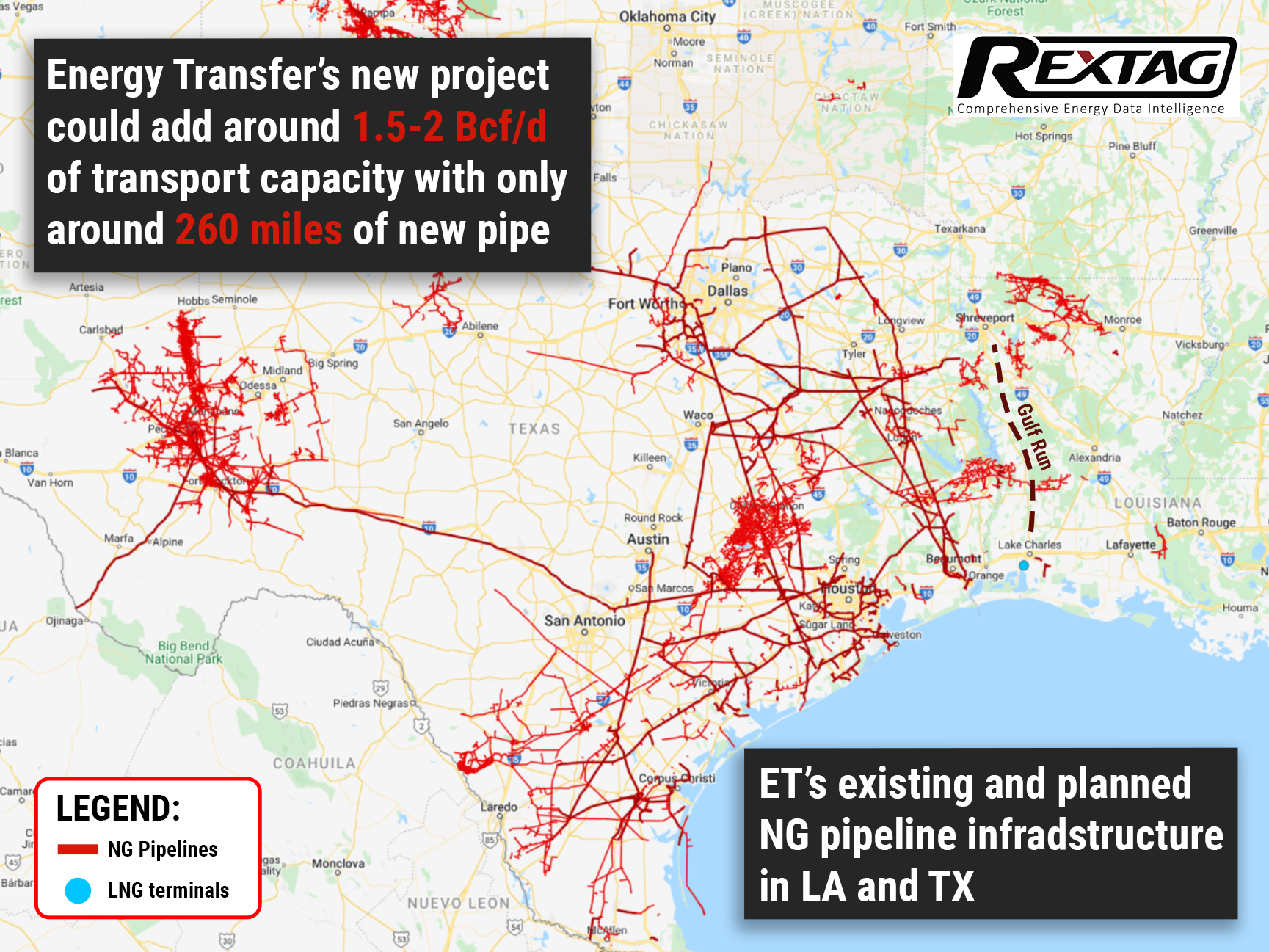Comprehensive Energy Data Intelligence
Information About Energy Companies, Their Assets, Market Deals, Industry Documents and More...
Energy Transfer LP Races to Carry Permian Basin Gas to Gulf Coast Hubs
03/01/2022
The Permian Basin's abundance of resources — given that it's the largest shale field in North America —, quickly became the driving force behind Energy Transfer LP's plans for a natural gas pipeline from West Texas and eastern New Mexico to export hubs on the Gulf Coast. The project under consideration would combine new and existing pipelines to serve coastal gas hubs.
A 260-mile new build pipeline would extend eastward from the Midland sub-basin along existing rights-of-way, interconnecting with Energy Transfer’s existing 36-inch pipeline near Fort Worth, Texas.
Given the proposed route and Energy’s ability to utilize existing assets, construction could be completed in two years or less once the parties involved have reached FID (final investment decision). The company's Co-CEO Thomas Long also corroborated this timeline.
A race to build pipelines in the Permian Basin has been triggered due to the increasing quantity of natural gas production under the Permian and the ever-increasing demand for natural gas exports from the Gulf Coast. Various companies, including Kinder Morgan Inc. and MPLX LP, are looking at building new pipelines in the region due to the demand spike.
Energy Transfer likely edged past Kinder Morgan and others into the lead for building the next Permian pipeline since the project strikes as the most economical option for the basin outside of capacity expansions on existing pipelines and could essentially add 1.5-2 Bcf/d of transport capacity with just 260 miles of new pipe.
Additionally, Energy Transfer announced that work had started on the Gulf Run Pipeline, which will connect Louisiana to the rest of the nation and international markets for natural gas transmission. To help meet growing global energy demand, existing assets will also be modified to complete the project.
Approximately 135 miles of the pipeline would run between Westdale and Starks. Enhancing and repurposing some underutilized infrastructure in northern Louisiana will be accomplished by modifying Line CP.
QatarEnergy and Exxon Mobil Corporation both have signed a 20-year agreement under which a $10 billion Golden Pass LNG export plant for this project is going to be built in Texas, and will provide 1.65 billion cubic feet of natural gas daily.
As a result of all those strings being pulled, Gulf Run should be completed by the end of 2022. At least according to Energy Transfer’s Top management statements.
But not all of Energy’s programs have “ongoing” or “underdevelopment” statuses. While management boasted about future prospects, there was also an announcement that the company had finally completed the last phase of its long-delayed Mariner East NGL pipeline expansion in Pennsylvania. A fine boost to the company's trust ratings. After all, actions speak louder than words.
If you are looking for more information about energy companies, their assets, and energy deals, please, contact our sales office mapping@hartenergy.com, Tel. 619-349-4970 or SCHEDULE A DEMO to learn how Rextag can help you leverage energy data for your business.
Evolution Acquires Non-operated Wyoming Natural Gas Interests
![$data['article']['post_image_alt']](https://images2.rextag.com/public/blog/Evolution-Acquires-Non-operated-Wyoming-Natural-Gas-Interests.png)
Evolution Petroleum just spend a fortune on Jonah’s Field right after acquiring Hamilton Dome Field in Wyoming. The price of the transaction is $29.4 million. The Houston-based company aims to diversify into natural gas assets, providing access to the western markets through the Opal market hub, with the optionality to flow to the east. That transaction took effect on February 1. We anticipate closing on or about April 1.
Look At The Future Of American And Appalachian Gas Production
![$data['article']['post_image_alt']](https://images2.rextag.com/public/blog/Look-At-The-Future-Of-American-And-Appalachian-Gas-Production.png)
The crux of the matter is rather simple: productivity gains of local energy operators have been stable not only because they are drilling better acreage, but also because players finally realized capital efficiency gains. And even if some new obstacles impede Appalachia's growth at the same rate as the Permian or Haynesville, it does not detract from the value of the Marcellus and Utica basins. The Appalachians will still be the top producers at a very competitive pace as long as commercial inventory exists. After all, as long as there is commercial inventory, somebody will have to drill.
![$data['article']['post_image_alt']](https://images2.rextag.com/public/blog/328_Blog_Why Are Oil Giants Backing Away from Green Energy Exxon Mobil, BP, Shell and more .jpg)
As world leaders gather at the COP29 climate summit, a surprising trend is emerging: some of the biggest oil companies are scaling back their renewable energy efforts. Why? The answer is simple—profits. Fossil fuels deliver higher returns than renewables, reshaping priorities across the energy industry.
![$data['article']['post_image_alt']](https://images2.rextag.com/public/blog/327_Blog_Oil Market Outlook A Year of Growth but Slower Than Before.jpg)
The global oil market is full of potential but also fraught with challenges. Demand and production are climbing to impressive levels, yet prices remain surprisingly low. What’s driving these mixed signals, and what role does the U.S. play?
![$data['article']['post_image_alt']](https://images2.rextag.com/public/blog/326_Blog_USA Estimated Annual Rail CO2 Emissions 2035.jpg)
Shell overturned a landmark court order demanding it cut emissions by nearly half. Is this a victory for Big Oil or just a delay in the climate accountability movement?